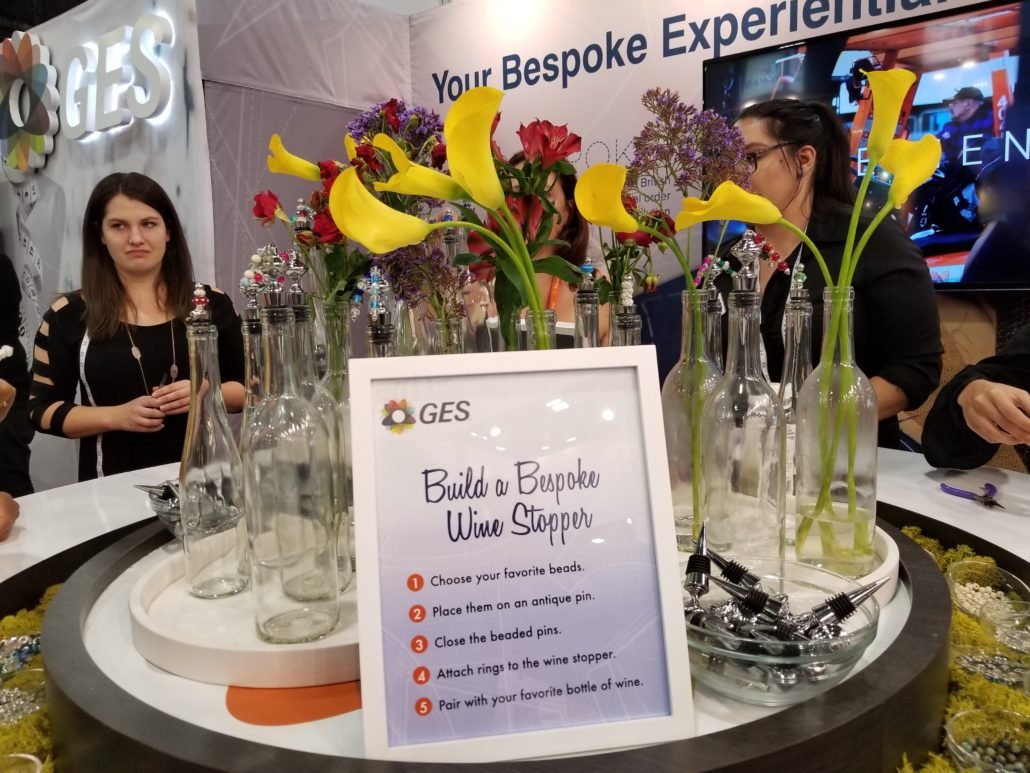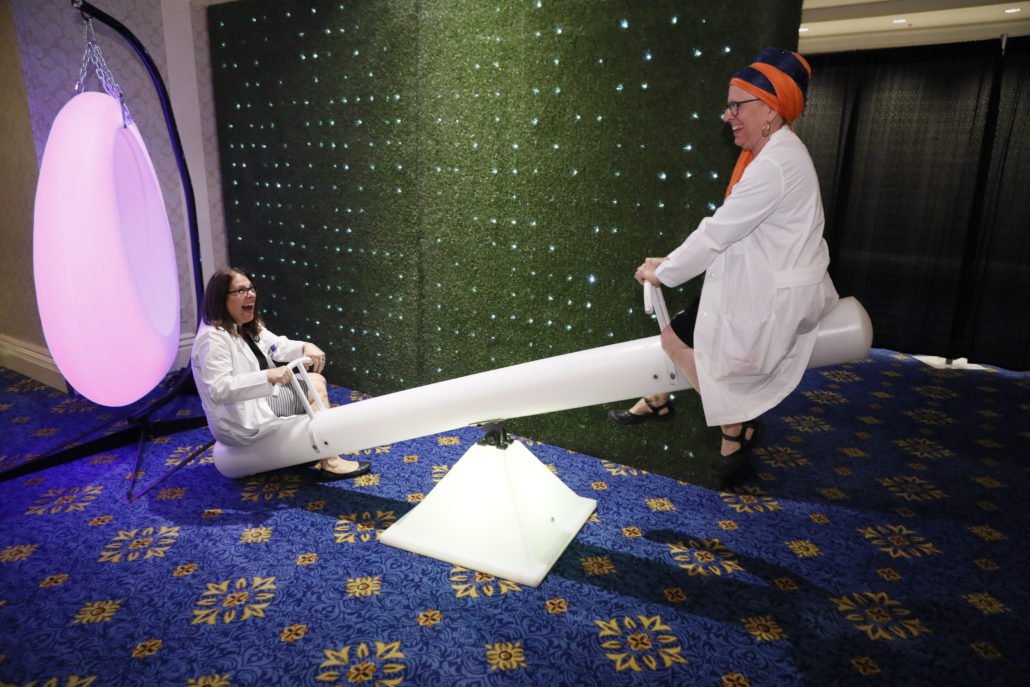Now that IMEX America 2019 is over, I want to share my experience with you. Spoiler alert: it was awesome! ?
Talking Event Psychology
First and foremost, I had the opportunity to speak about Event Psychology! I was already excited about sharing insights on applying psychology and neuroscience to events with fellow event professionals, but my excitement reached new heights when I entered a packed seminar room with people standing around. It’s difficult to put into words, but it gave me goosebumps! Clearly, the event community is increasingly interested in this topic. I can see this from the feedback I received online, my own session experience, and even from looking at the IMEX agenda, which featured several similar topics like measuring emotions and using science-backed methods to enhance learning and networking experiences.

Science-based Ways to Boost Engagement
Secondly, I’d like to share three cool things I experienced firsthand at IMEX that are closely related to the subject I mentioned earlier, particularly the concept of engagement I discussed during my presentation. Here are these three things.
Unleashing the Power of Co-creation
There is never a shortage of creativity among exhibitors at IMEX. You can find all kinds of great ideas implemented at every booth designed to attract visitors: from wax figures of Channing Tatum and Bradley Cooper (looking very much alive) to giant chairs and even a flower lady. However, it is co-creation or co-experience that truly drives the best engagement. My observations at this and other trade shows once again confirmed this, which is not surprising if you understand the psychology involved.
Let me provide a few examples from IMEX 2019. First, there was a live box training session at Thailand’s booth, allowing attendees to participate actively. Then, there was the opportunity to send a postcard from Taiwan, adding a personal touch to the experience. New Zealand’s booth offered a traditional Maori tattoo, providing a unique cultural encounter. Finally, at GES’s booth, attendees could create their own bespoke wine stopper (shown below), adding a touch of customization to their visit.

Participants were actively involved in designated activities in all of these examples. This active involvement is what makes them stand out, increases engagement, and transforms them into meaningful, potentially business-building actions.
Scientific research confirms the benefits of co-creation. For instance, a study published in this article demonstrates that “co-creating with consumers can be a strategic method to positively influence product perceptions and behavioral intentions.” Another study suggests that engaging in co-creation activities contributes to consumer satisfaction.
It is also essential to consider the IKEA effect, a cognitive bias that leads people to value things they have created more highly. Here you can find a comprehensive explanation of this phenomenon: “The effect has a range of possible explanations, including positive feelings such as a sense of competence that arise from successfully completing a task, a focus on the positive attributes of the product, the link between effort and liking, the connection between our creations and our self-concept, as well as the psychological sense of ownership.”
Mindful Event Space Design: Meet the Nook Pods
As I made my way towards the exit at the end of the day, something caught my attention—a cute little half-‘house’ where two men were engaged in a conversation. Intrigued, I slowed down and David and Dan kindly invited me to take a seat. It turned out that the house I had been curious about was a cozy, multifunctional space meticulously designed to cater to the needs of both event organizers and audiences.
Not only did I appreciate the product itself, with its portable nature, noise-dampening features, and customizable options, but I also thoroughly enjoyed learning about the concept behind it. The underlying idea was all about eliminating friction and distractions along the way, ultimately creating a better event experience for attendees.

Here’s how this relates to event psychology: Research indicates that the more comfortable our environment is, the more engaged, focused, and satisfied we become. This concept is also emphasized in the book “Professional Meeting Management: A Guide to Meetings, Conventions, and Events,” which highlights the importance of attendee comfort. By offering a comfortable, intimate, and easily adaptable environment, Nook demonstrates a commitment to meeting attendees’ diverse needs. Whether it’s providing a space to charge their phones, facilitating meetings, or offering a quiet spot for relaxation and mental downtime, Nook helps organizers convey their genuine concern for attendee well-being. The result? Happy participants, which is ultimately the goal event planners strive to achieve.
Emotional Therapy: Laughter Yoga Sessions
As I prepared my presentation for IMEX19, I was filled with excitement about including a laughter yoga session as a practical activity. It’s an activity that many people are not aware of, let alone have experienced, yet it offers numerous benefits that I believe should be a must-have for any event. Allow me to present the evidence, and you can be the judge: it’s not only fun (which is at its core), but it’s also a healthy practice (after all, it is yoga) that helps spread positive emotions among the group of individuals gathered together.

A combination like this is undoubtedly a winning one, and it is supported by scientific evidence as well. Research has demonstrated that laughter has a significant impact on both our bodies (such as burning calories, increasing heart rate and respiration, and stimulating the immune system) and our minds (by reducing stress and improving memory and concentration). On the other hand, the yoga element focuses on relaxation, mindfulness, and concentration. When we share the positive emotions that come with laughter and combine them with the principles of yoga, it contributes to an overall sense of satisfaction with the event experience. Therefore, I would confidently say that among the various activities available, laughter yoga sessions are firmly rooted in psychology.
Imagine my surprise when I opened the IMEX agenda and discovered that laughter yoga sessions were included. I immediately made a note to participate, and I can happily say that the Laughter Lab conducted by Sarah and Rachael did not disappoint.
(Upd-1: here is an interesting podcast about neuroscience of laughter)
(Upd-2: for more fun activities and inspiration, check out this thread from the EventPlannersTalk twitter chat I co-hosted in July 2021).
Your TAKEAWAY
The event community is increasingly acknowledging the benefits of incorporating behavioral science knowledge into events. This is evident from the feedback received from my IMEX session and other examples within the industry. It is crucial to recognize that event psychology is already a must-have skill, regardless of whether you have implemented it in your events or not.
Are you eager to master event psychology, enabling you to enhance attendee engagement, increase attendance, and deliver exceptional online or in-person events? If your answer is yes – get in touch with me: matey.events@gmail.com



